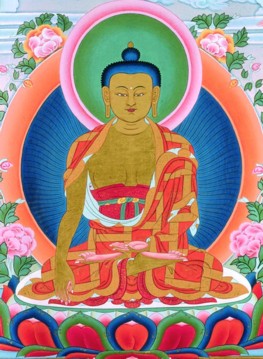 Editor's Note: I wrote this post for my readers who - in my recent reader survey - said they're curious about Buddhism. But really, it's about the peace, compassion, and wisdom we all so deserve.
Editor's Note: I wrote this post for my readers who - in my recent reader survey - said they're curious about Buddhism. But really, it's about the peace, compassion, and wisdom we all so deserve.
When I was in my mid-twenties, my housemate went to see a psychic. Suprisingly, the psychic began speaking about me, the young woman who drank and smoked too much. She predicted I would either meet a spiritual teacher or cross over in my early thirties. That means die, in case it’s not clear.
I found this strange and spooky and largely put it out of mind. I wasn’t spiritually inclined at the time so the possibility of becoming so seemed unlikely. I started to drink less, but not because of the prediction. Alcohol soothed my frazzled emotions and helped me to relax. But I knew it wasn’t healthy or helpful on the long run. It would be a long time before I gave up smoking, but I continued to breathe and walk on this earth, nevertheless.
At the time, I lived by the sea in Santa Cruz, California, magnet to surfers, valley girls, tourists and alternative lifestyle seekers. The town and surrounding areas hosted a panoply of spiritual culture from WICCA covens to the Mt. Madonna Center, where the main yoga teacher had been silent for more than 20 years and communicated by writing on a small chalkboard he wore around his neck. (He's brilliant, by the way.)
I never gave a second thought to any of this as I was busy running a non-profit that helped battered women.
Then, suddenly in my early thirties, as predicted but still unexpected, I fell into Buddhism. A brand new housemate was fired up about meditation and Buddhism. She took me to talks and sittings held in a remodeled garage. But, I found the atmosphere of this particular group too stiff. Buddhism, I concluded, was not for me.
Or so I thought. Soon after, I was lured to another talk given by a different teacher. I felt deeply moved by his words and the special ambiance created by the power of his presence. Since I was between jobs, I went for a weekend seminar too and then a ten-day retreat held at the end of a long and bumpy dirt road.
Although I had to stay in a tent and got a rip roaring case of poison oak, by the end of the retreat, there was no question: I was fully hooked on Buddhism.
Buddhism captured me because:
- It made so much sense to my mind and heart. Even though I didn’t understand everything and I thought all the Tibetan mumbo jumbo didn’t concern me, the truth of the teachings spoke so clearly to both my conceptual and non-conceptual mind.
- I probably had a karmic connection from a past life that had come to fruition bringing me squarely into the heart of Buddhism. But, a karmic connection won’t necessarily keep you there unless you create new karma by applying yourself in study and practice.
Since then, I’ve attended hundreds of talks, seminars, and retreats on the teachings and practices of Buddhism, include a three-year study and practice retreat. Of course, I'm still a beginner and have much to learn. Until the three-year retreat, you would usually find me busy working. Remember, I was a workaholic. But, I made up for the lost practice time once on the extended retreat and have continued a daily practice since then.
The Many Colors of Buddhism
By the way, I’m not trying to sell you on Buddhism. But, if you're curious about Buddhism, it may help to know that it comes in many different shapes, sizes, and colors. There’s the black and white simplicity of Zen, the vivid orange and red of Tibetan Buddhism, and the saffron colored robes seen in Southeast Asia. Different hues exist even within a single tradition.
There are peaceful monks, learned scholars, wild, unconventional teachers, householders, and cave dwelling yogis.
It is said that Shayamuni Buddha gave 84,000 different teachings and taught in different ways according to the minds and capacities of different individuals. His teachings are divided into three main categories (known as "vehicles"), which respectively emphasize peace, love and compassion, and skillful means for developing wisdom.
As you can see, there isn’t just “one” Buddhism. Although there are a few core principles that run the gamut of traditions, the language and approaches vary dramatically. That doesn't mean it's a free-for-all thanks to lineage. The authentic teachings are carefully passed down from one teacher to the next. But, of course, ultimately you need to realize the teachings within your own mind.
The Essence of Buddhism
The teachings of the Buddha are vast, indeed. Just the words of the Buddha alone fill 100 volumes and the commentaries by great Indian scholars fill more than 200. And, that’s just the tip of the iceberg when you consider all the Buddhist teachings that have been spoken and written since then.
At the same time, the Buddhist teachings can be encapsulated in a few words. For example, The Buddha summarized his teachings in these four lines:
“Commit not a single unwholesome action. Cultivate a wealth of virtue. To tame this mind of ours. This is the teaching of all the buddhas.”
-the Dhammapada
An entire book could be written about this verse. But simply said, it means to refrain from harm, to cultivate love, compassion, and beneficial actions, and to purify your own mind and heart from its patterns of negativity.
Meditation is the method used to transform the mind and there are several different forms of meditation. For example, there's the basic meditation of mindfulness, contemplative meditation, practices of loving kindness and compassion, and, in some traditions, deity practices that involve visualization and mantra and both the investigation of mind as well as resting in the nature of mind once it's been introduced.
It all depends on the approach of your tradition. You may be drawn to the simplicity of sitting or love the complexity and symbolism of rituals.
I'd like to mention one other simple explanation of Buddhism: The action of Buddhism is non-harming and the view (core principle) is interdependence. It's important to realize that Buddhism isn't just about understanding your own mind, but it also addresses the nature of reality. Its most fundamental tenet proposes that everything is impermanent, empty of inherent existence, and comes about due to cause and effect. Therefore, what we think, say, and do has an effect for better or for worse.
To sum up, Buddhism can be described in two words: compassion and wisdom. But then again, each of those words and the associated practices could be explained in volumes.
Why It Matters: Putting An End to Suffering
In essence, Buddhism is about transforming negative emotions, cultivating positive qualities, remaining present in the moment, and seeing reality as it is rather than through the projections of your ordinary mind.
“If we know this, (if we are wise) we can see than any happiness or any suffering, depends entirely on the mind and how it perceives. So we will seek to find happiness and well-being within our own mind, and nowhere else. We know that since all the causes of happiness are already here, complete within us, it doesn’t depend on anything outside of us.” - the 3rd Dodrupchen Rinpoche
When you lack the capacity to work with your own mind and emotions, you suffer. Thoughts and emotions easily sweep you away making you feel distressed and uncomfortable in your own self. At the same time, you’re more likely to cause suffering for others because you are reacting from habitual, self-focused patterns. And, that's how the world becomes a turbulent mess.
Instead of identifying with transitory thoughts and emotions, you could switch your allegiance and begin to rest in the essence of mind (pure awareness). This is what we learn to do in meditation and why it is so powerful. From this spacious perspective, thoughts and emotions are just clouds sweeping through a vast, open sky. They can’t really harm you if you don’t go along for the ride. Learning to take your emotions less seriously is the beginning of true freedom.
You don't have to be a Buddhist to believe in the core principles of Buddhism. I'm not bent on converting anyone to Buddhism. I would, however, love to convert the whole world to peace, compassion, and wisdom. Then, we would see heaven on earth.
Resources
These days, it can be difficult to distinguish between an authentic teacher and someone who claims to be self-realized. And, there are plenty of people who say you don’t need a spiritual teacher at all. Just listen to your inner voice! That might be a big mistake though, because ego can be very cunning.
I place my trust in lineage: The fact that a teacher has learned from a bonafide teacher who in turn learned from another.
For those who are curious about Buddhism, I’ve compiled a list of resources you can explore that features a selection of teachers who are part of an authentic lineage. They’re slanted toward Tibetan Buddhism because that’s my thing.
Video, Audio, and Articles
- A Treasury of Free Resources to Inspire Your Meditation, Compassion and Wisdom - video, audio, and written teachings from a range of Eastern and Western Buddhist teachers.
- Dare to Meditate: Free 10-Step Introduction to Meditation - Shows you mindfulness meditation step-by-step.
- The Posture in Meditation with Elizabeth Namgyel Mattis
Books on Meditation, Compassion, and Wisdom
- The Joy of Living, Unlocking the Secret and Science of Happiness by Yongey Mingyur Rinpoche
- Rebel Buddha, A Guide to a Revolution of Mind by Dzogchen Ponlop Rinpoche
- Open Heart, Open Mind, Awakening the Power of Essence Love by Tsoknyi Rinpoche
- Zen Mind, Beginners Mind by Shunryu Suzuki
- The Power of An Open Question by Elizabeth Mattis Namgyel
- When Things Fall Apart: Heart Advice for Difficult Times by Pema Chodron
- Loving Kindness, The Revolutionary Art of Happiness by Sharon Salzberg
That's the story of my love affair with Buddhism. To this day, the practice and teachings open my mind and soften my heart. I feel so blessed!
How do you cultivate peace, compassion, and wisdom in your life?
Thank you for your presence, I know your time is precious! Don’t forget to sign up for my e-letter and get access to all the free self-development resources (e-books, mini-guides + worksheets) in the Always Well Within Library. May you be happy, well, and safe – always. With love, Sandra
Image Credit: Natural Bridges - Moonx


